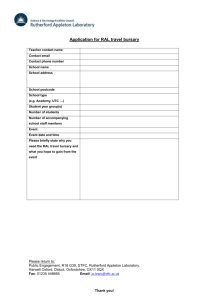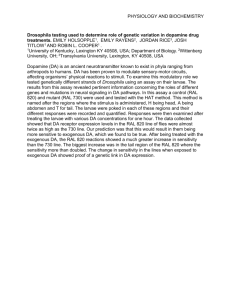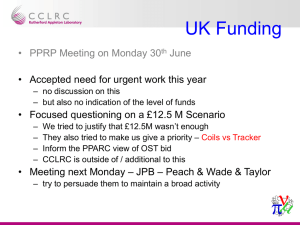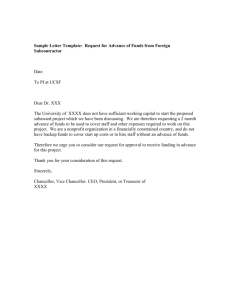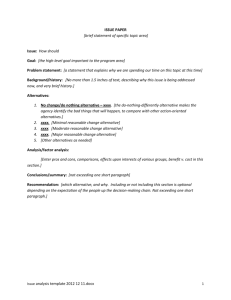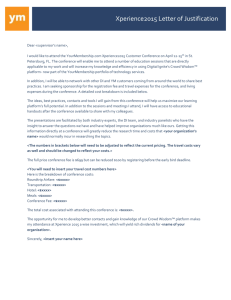Evaluating the Risk Acceptance Ladder (RAL)
advertisement
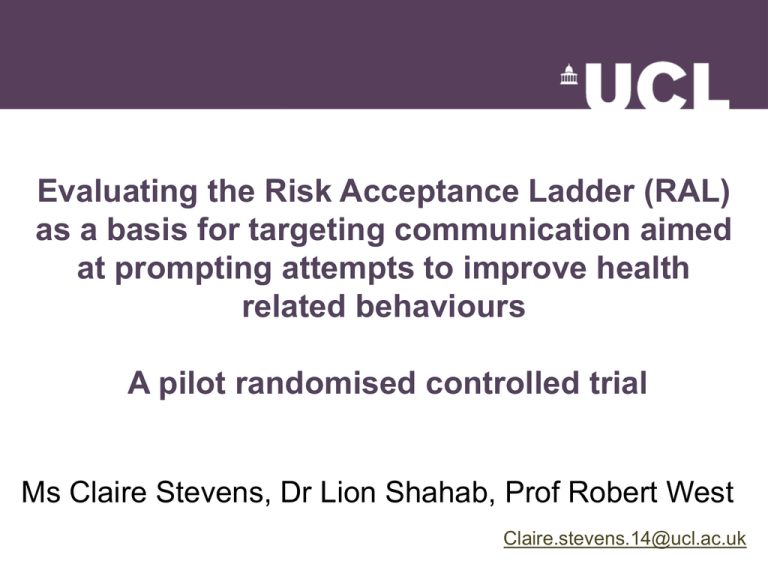
Evaluating the Risk Acceptance Ladder (RAL) as a basis for targeting communication aimed at prompting attempts to improve health related behaviours A pilot randomised controlled trial Ms Claire Stevens, Dr Lion Shahab, Prof Robert West Claire.stevens.14@ucl.ac.uk The Risk Acceptance Ladder (RAL) • A tool designed to gauge the reasons why people participate in risky health behaviours, or do not participate in protective health behaviours • Currently 4 versions of the RAL covering the following behaviours - smoking, alcohol consumption, physical activity, fruit and vegetable consumption • Users self-select one of nine statements which best describes the reason for their behaviour • This selection serves as a basis for delivering targeted interventions The RAL and the COM-B model of behaviour • The COM-B model is the central component of the behaviour change wheel. • In order for a behaviour to occur, a person must have the necessary capability, opportunity and motivation. The COM-B model (Michie, van Stralen & West, 2011, Implementation Science) • The RAL is a way of putting the COM-B model into practice to understand health behaviour. The RAL A) I have not heard that XXXX was harmful or risky B) I have heard that XXXX is risky but never fully understood what the problem is C) I understand what people are saying about the risks of XXXX, but I don’t believe it D) I accept that XXXX is risky but don’t care enough to do anything about it E) I think it is worth XXXX, but it is not a priority at the moment F) I don’t think I can XXXX because things in my social world make it too difficult G) I don’t think I can XXXX because things going on in my life make it too difficult H) I don’t think I can XXXX because I don’t have the self-control I) I want to XXXX, but I don’t know how best to do it J) None of the above - Please specify……………. The RAL – Capability I have not heard that XXXX is harmful or risky I think it is worth XXXX, but it is not a priority at the moment I don’t think I can XXXX because things in my social world make it too difficult The RAL – Motivation I have not heard that XXXX is harmful or risky I think it is worth XXXX, but it is not a priority at the moment I don’t think I can XXXX because things in my social world make it too difficult The RAL – Opportunity I have not heard that XXXX is harmful or risky I think it is worth XXXX, but it is not a priority at the moment I don’t think I can XXXX because things in my social world make it too difficult The present study Primary Aim: Assessing the ability of the RAL as a self-report tool to understand people’s participation in a range of health behaviours • Acceptability • Distribution of responses Secondary Aim: Evaluate the utility of the RAL as a basis for developing tailored interventions aimed at prompting attempts at behaviour change • Behavioural test Procedure and participants 816 Participants recruited into online study Convenience sample Remaining participants assigned to one target behaviour 601 175 With target for behaviour change No plans to change behaviour The RAL Randomised to on-target or offtarget intervention RAL – Interventions Participants were randomly assigned to either a brief, behaviour specific on-target or off-target intervention. 175 Eligible participants On-target intervention Relates to RAL position N = 83 Off-target intervention Does not relate to RAL position N = 92 RAL – Intervention example RAL response – ‘I have not heard that smoking was harmful or risky’ On-target intervention Off-target intervention Not everyone knows quite how harmful smoking is. If they do not stop, smokers die an average of 10 years earlier than non-smokers and smokers suffer from diseases of old age much earlier than non-smokers. There is no safe level of smoking. People who do not smoke every day still suffer a huge increase in risk, particularly from heart disease. It can be hard to stop smoking when people around you smoke – there are just too many temptations. But people do manage it every day and if one person in a group stops this can prompt others to stop. Stopping smoking at any age leads to a longer, happier, healthier life. Stopping is incredibly important, whatever the obstacles and there is lots of good advice available on how to cope with others smoking when one is trying to stop. RAL – The behavioural test Are people who received an on-target intervention more likely to click on a link offering advice than those who received an off-target intervention? Results Acceptability of the RAL and response distribution • 70% of participants were able to select an existing RAL item • 63% of participants thought that it was quite or very easy to select one RAL item Results Behavioural test Logistic regression – Grouping (on/off-target) as a predictor of link clicking OR=3.321, 95% CI = 1.613-6.838, P=.001 Conclusions • The RAL appears to have reasonable acceptability – but there is need for improvement • The RAL might be a useful screening tool and basis for targeted interventions as indicated by the behavioural test Future directions • Using ‘other’ responses to expand / refine the RAL • Selecting multiple RAL items • More complex interventions • Measures of behaviour change Thank you Questions?
